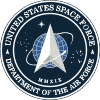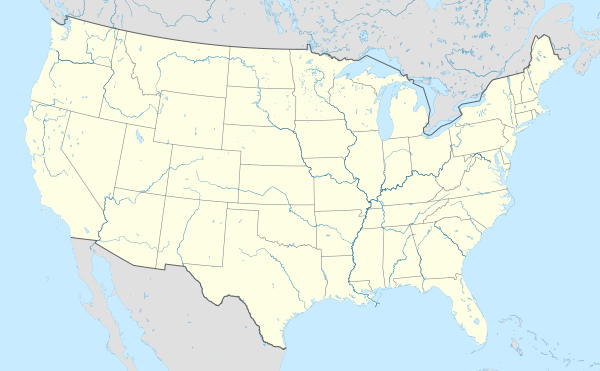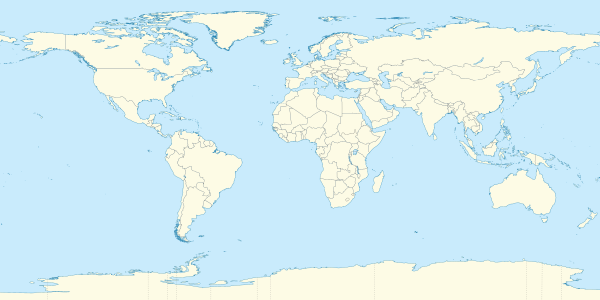
A | B | C | D | E | F | G | H | CH | I | J | K | L | M | N | O | P | Q | R | S | T | U | V | W | X | Y | Z | 0 | 1 | 2 | 3 | 4 | 5 | 6 | 7 | 8 | 9
The United States Space Force (USSF) is the United States Armed Forces' space service and one of the eight uniformed services of the United States. It is one of two independent space forces in the world, alongside the Chinese People's Liberation Army Aerospace Force.[6]
The United States Space Force traces its origins to the Air Force, Army, and Navy's military space programs created during the beginning of the Cold War. Space forces first participated in combat operations during the Vietnam War and have participated in every U.S. military operation since, most notably in the Persian Gulf War, which has been referred to as the "first space war." The Strategic Defense Initiative and creation of Air Force Space Command in the 1980s marked a renaissance for military space operations.
Proposals for a U.S. Space Force were first seriously considered during the Reagan Administration as part of the Strategic Defense Initiative. Congress began exploring establishing a Space Corps or Space Force in the late 1990s and early 2000s. The idea of establishing a Space Force was resurrected in the late 2010s in response to Russian and Chinese military space developments; the Space Force was established on 20 December 2019.
The Space Force is organized as part of the Department of the Air Force alongside the U.S. Air Force, its coequal sister service. The Department of the Air Force is headed by the civilian secretary of the Air Force, while the U.S. Space Force is led by the Chief of Space Operations. The U.S. Space Force's status as part of the Department of the Air Force is intended to be an interim measure towards a fully independent Department of the Space Force, led by a civilian secretary of the Space Force.
Mission
Secure our Nation's interests in, from, and to space.
— Mission statement of the United States Space Force[6]
The Space Force's statutory responsibilities are outlined in 10 U.S.C. § 9081 and originally introduced in the United States Space Force Act, the Space Force is organized, trained, and equipped to:
- Provide freedom of operation for the United States in, from, and to space;
- Conduct space operations; and
- Protect the interests of the United States in space.
The Department of Defense further defines the specified functions of the Space Force to:[7]
- Provide freedom of operation for the United States in, from, and to space.
- Provide prompt and sustained space operations.
- Protect the interests of the United States in space.
- Deter aggression in, from, and to space.
- Conduct space operations.
The Space Force further breaks down its mission into three core functions, which align directly to its mission statement to "secure our Nation's interests in, from, and to space:"
- Space Superiority (in space)
- Global Mission Operations (from space)
- Assured Space Access (to space)
Space Superiority

Space superiority defends against space and counterspace threats by protecting spacecraft in space or protecting against attacks enabled by adversary spacecraft, requiring that the Space Force establish control of the domain. The Space Force describes that at a time and place of the United States' choosing it must be able to assure continued use of spacecraft and deny adversaries use of their spacecraft or space-enabled capabilities.[6]
Mission that support space superiority include orbital warfare, electromagnetic warfare, and space battle management.[6]
Global Mission Operations

Global mission operations integrates joint functions across all domains (land, air, maritime, space, cyberspace) on a global space. Through space, the U.S. military and its allies can see, communicate, and navigate. Global mission operations also protect U.S. forces on Earth through early warning of incoming missiles and other types of attack. The Space Force describes global mission operations as allowing the rest of the U.S. military to defend the air, land, and sea.[6]
Missions that support global mission operations include missile warning, satellite communications, and positioning, navigation, and timing.[6]
Assured Space Access

Assured space access ensures that the Space Force can deploy and sustain equipment in outer space. This includes space launches as well as controlling and steering spacecraft out of the way of oncoming space debris to avoid collisions. The Space Force describes assured access to space as being able to make sure it can continue launching and conducting space operations 24/7.
Missions supporting space access include launch, range control, cyber, and space domain awareness.[6]
History
The U.S. military in space
In the long haul, our safety as a nation may depend upon achieving "space superiority." Several decades from now, the important battles may not be sea battles or air battles, but space battles, and we should be spending a certain fraction of our national resources to ensure that we do not lag in obtaining space supremacy.

The beginnings of the U.S. Space Force can be traced to the Aftermath of World War II. General Henry H. Arnold, commander of the Army Air Forces, tasked General Bernard Schriever to integrate with the scientific community to identify and develop technologies that could be beneficial for the new U.S. Air Force in the next global conflict.[6] Identifying the importance of space, the U.S. Army, U.S. Navy, and U.S. Air Force each started their own separate space and rocket programs. The U.S. Air Force created the first military space organization in the world, establishing the Western Development Division in 1954 and placing it under the command of General Schriever.[9] The Army followed a year later, creating the Army Ballistic Missile Agency under the leadership of General John Bruce Medaris and Dr. Wernher von Braun.[10]
The Army led the United States into space, launching the first American spacecraft, Explorer 1, on 31 January 1958.[6] Space exploration continued to be a military responsibility until the National Aeronautics and Space Administration was created in 1958.[11] The military shifted from conducting their own space exploration programs to supporting NASA's, providing the agency with its astronauts and space launch vehicles, while also conducting astronaut recovery and supporting space launches from the Air Force's Eastern Range.[11]
The Air Force was recognized as the lead military service for space by the early 1960s, with the Army and Navy operating in supporting roles. Early military space efforts were focused on developing and fielding spacecraft to accomplish national objectives, with a focus on weather, reconnaissance and surveillance, communications, and navigation. On 18 August 1961, the Air Force and National Reconnaissance Office launched the first CORONA reconnaissance mission, recovering 3,000 feet of film from space and imaged 1.65 million square miles of the Soviet Union's territory.[6]

Concerned about the development of the Soviet Union's own space forces, the Air Force advocated for a military human spaceflight program. General Curtis LeMay described strong parallels between World War I aviation and 1960s space operations, noting how quickly flying evolved from chivalric and unarmed reconnaissance flights to combat efforts designed to destroy enemy air superiority. General LeMay believed that it was naive to believe that the same trends were not expected to be seen in space and must be prepared for. Although the Air Force made significant progress in developing the X-20 spaceplane, Manned Orbiting Laboratory, and Blue Gemini, opposition from the Department of Defense prevented operational fielding. The Air Force was also forced to cancel Project SAINT, a satellite inspector with satellite neutralization capabilities, when details were leaked to The New York Times in 1962. Despite these setbacks, the Air Force did successfully field the Program 437 anti-satellite weapon system, which used nuclear Thor missiles to intercept enemy spacecraft.[11]
Although most military space forces were organized under the Air Force, they were still fragmented within several different major commands. Recognizing rapid growth of space forces and the need to centralize them under one command, the Air Force established Air Force Space Command in 1982.[6] This was followed by the establishment of the joint United States Space Command in 1985, aligning Air Force Space Command, Naval Space Command, and Army Space Command under a single operational commander. These two moves, along with the Strategic Defense Initiative's establishment by President Ronald Reagan, led to a renaissance of military space operations in the 1980s.[11]
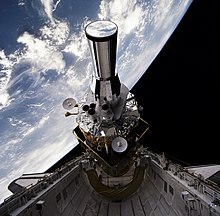
Space forces were first used in combat operations during the Vietnam War, with Air Force weather and communications spacecraft supporting ground, sea, and air operations.[11] During Operation Urgent Fury in Grenada, satellite communications were used to conduct command and control for the first time, while Operation El Dorado Canyon and Operation Just Cause marked the first time that major U.S. forces incorporated information from space-based intelligence systems.[12]
The Persian Gulf War marked the first time that military space forces were unleashed to their fullest extent. Over sixty spacecraft provided 90% of theater communications and command and control for a multinational army of 500,000 troops, weather support for commanders and mission planners, missile warning of Iraqi Scud missile launches, and satellite navigation for air and land forces moving across a featureless desert.[11][13] The decisive role that space forces played directly enabled an overwhelming Coalition victory and led to the Persian Gulf War being coined "the first Space War."[14]
While U.S. space forces supported all U.S. military operations in the 1990s, Operation Allied Force marked the first use of Global Positioning System-aided munitions in a conflict, ushering in a new era of precision bombing.[15] Following the September 11 attacks, U.S. space forces mobilized to respond as part of the Global War on Terroism Operation Enduring Freedom, Operation Iraqi Freedom, and Operation Inherent Resolve.[16]
Path to a separate space service
Creating a new military service...would be a dramatic step. Perhaps a "Space Corps" would be a step toward a Space Force. Maybe the Air Force will preempt these dramatic changes by truly becoming the "Space and Air Force."

The idea of a separate service for space originated in the 1960s. Military space activities were briefly consolidated under the Advanced Research Projects Agency in 1958, loosely centralizing space activities under a single organization. The Air Force, Army, and Navy feared that it would evolve into a "fourth service" for space, before authorities were returned to the service.[11]
The first direct call for a U.S. Space Force occurred in 1982, prior to Air Force Space Command's establishment or the Strategic Defense Initiative's public announcement. As part of a report recommending the acceleration U.S. space-based laser weapon development, the Government Accountability Office recommended the U.S. Air Force be reorganized as the U.S. Aerospace Force or that an independent U.S. Space Force be created.[17] Ultimately, a Congressional proposal to rename the U.S. Air Force as the U.S. Aerospace Force and speculation that President Ronald Reagan may announce the creation of a U.S. Space Force accelerated Air Force plans to create a space command within the service.[11]
Following the Persian Gulf War, the Air Force and Defense Department declared that "space power has now become as important to the nation as land, sea, and air power." Despite this public pronouncement, a growing section of Congress believed that space was being shortchanged and used only as an auxiliary to air operations. In 1998, drawing parallels between the challenges faced by post-World War I Army Aviators and post-Gulf War Air Force space operators, Senator Bob Smith publicly called for the establishment of a Space Force if the Air Force could not, or would not, embrace spacepower. An independent Department of the Space Force would ensure that space got its fair share of resources within the Defense Department, with Senator Smith calling for the creation of a Space Corps within the Department of the Air Force as a bridge to a fully independent Space Force.[17]
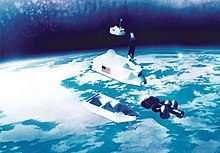
In 2000, Senator Smith led Congress in establishing a commission to examine the organization and management of national security space. The Commission to Assess United States National Security Space Management and Organization, better known as the 2001 Space Commission or the Rumsfeld Commission, released its report in 2001. The Rumsfeld Commission noted the strong risk of a "Space Pearl Harbor," harking back to Imperial Japan's surprise attack on the U.S. Pacific Fleet in 1941. It was extremely critical of the Air Force's treatment of space, with few witnesses expressing confidence that the Air Force would address the requirement to provide space capabilities to the other services or move beyond treating space as just a support capability for air operations. The most significant recommendation of the Rumsfeld Commission was the creation of a Space Corps within the Department of the Air Force in the mid-term, which would evolve into a Department of the Space Force in the long-term. The Rumsfeld Commission expected the transition from Air Force Space Command to a fully independent Space Force to occur in between 2006 and 20011. [17][18]
Air Force leadership reacted extremely poorly to the Rumsfeld Commission's recommendations. The day after the Commission was publicly released Air Force Chief of Staff General Michael E. Ryan declared "an independent Space Force or Corps was not warranted for at least another 50 years." General Ryan doubled down over the following year, stating that a Space Force should only be considered once space operations moved beyond Earth orbit. Despite the Air Force's hostility to the idea of a Space Corps or Space Force, they did meet some recommendations by transferring the Space and Missile Systems Center from Air Force Materiel Command to Air Force Space Command and establishing the National Security Space Institute.[19] Ultimately, the Rumsfeld Commission's recommendations remained unfulfilled because of the higher priority placed on counterterrorism after the September 11 attacks, canceling plans for a Space Corps within the Department of the Air Force or a fully independent Space Force by 2011.[20]

While the United States' focus shifted from space to counterterrorism, the Russian Armed Forces and Chinese People's Liberation Army realized the military benefits that could be gleaned from space, as well as the incredible reliance the United States put on its space forces. Throughout the 2000s, Russian and Chinese space and counterspace capabilities began to increase.[6] In 2001, the Russian Space Forces were reestablished as an independent arm and in 2007, China conducted a destructive anti-satellite missile test causing the single largest space debris generating event in history.[21][22][23] In the aftermath of the Chinese ASAT test, Congress tasked the Allard Commission to reevaluate the Defense Department's space organization and management. The Allard Commission noted that the United States' dependence on space had increased, but comparatively little... been achieved to make them more secure." It also noted, despite the recommendations of the Rumsfeld Commission, authority and responsibility for national security space remained fragmented and unfocused. Like the 2001 Rumsfeld Commission, the 2008 Allard Commission recommended establishing a Space Corps within the Department of the Air Force or a separate Department of the Space Force to unify national security space. [17]
It took until 2017 for members of Congress to act on the recommendations of the Rumsfeld and Allard commissions to create a Space Corps within the Department of the Air Force. Representatives Mike Rogers and Jim Cooper unveiled a bipartisan proposal to establish a Space Corps within the Department of the Air Force, however it experienced significant opposition from the Air Force and Defense Department, failing in the Senate. [24][25] However, the proposal was resurrected in 2018 when President Donald Trump publicly endorsed the creation of a Space Force and directed the Defense Department to reverse its opposition and develop plans for its establishment.[26][27] The Trump Administration plan for the U.S. Space Force was outlined in Space Policy Directive-4, initially organizing the U.S. Space Force as part of the Department of the Air Force, but with plans to build out a separate Department of the Space Force in the future.[28] In 2019, Congress passed legislation establishing the U.S. Space Force as a military service under the Department of the Air Force. On 20 December 2019, the National Defense Authorization Act was signed into law and the U.S. Space Force was established as the sixth armed service, meeting the Rumsfeld and Allard commissions' recommendations to create a Space Corps within the Department of the Air Force, but still falling short of creating a separate Department of the Space Force.[17]
The sixth service
We are at the dawn of a new era for our Nation’s Armed Forces. The establishment of the U.S. Space Force is an historic event and a strategic imperative for our Nation. Space has become so important to our way of life, our economy and our national security that we must be prepared as a Nation to protect it from hostile actions.
— Secretary of Defense Mark Esper, 20 December 2019[29]
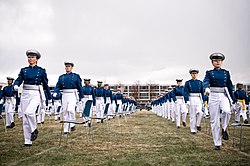
As the U.S. Space Force was established on 20 December 2019, General Jay Raymond, commander of U.S. Space Command and Air Force Space Command, became its first member and chief of space operations. Air Force Space Command was immediately redesignated as United States Space Force, however, the command and its 16,000 Airmen technically remained part of the Air Force.[30] On 3 April 2020, Chief Master Sergeant Roger A. Towberman became the Space Force's second member and was appointed its first senior enlisted leader.[31] The service gained its first new second lieutenants when 86 members of the U.S. Air Force Academy class of 2020 became Space Force members 3 through 88 on 18 April 2020.[32] Currently serving Air Force space operators began to become Space Force members in September 2020 and the service gained its first astronaut when Colonel Michael S. Hopkins swore into the Space Force aboard the International Space Station on 18 December 2020.[33][34][35][36]
The Space Force also began to build out its culture and identity, however, it experienced several public relations challenges due to its perceived ties to science fiction and links to President Trump.[37] The Space Force adopted the Army and Air Force's OCP Uniform with blue stitching and a full color U.S. flag, sparking jokes about fighting on the forest moon of Endor from Star Wars: Return of the Jedi, while its distinctive service dress drew comparisons to Colonial Fleet uniforms from Battlestar Galactica or Starfleet uniforms from Star Trek. While the Space Force noted that its camouflage combat uniform was appropriate since space operators deploy to combat zones on the Earth alongside the rest of the joint force and it saved money, it did not have a similar response for its service dress uniform, which were described as a "futuristic-looking" design by General Raymond.[38][39][40][41] The Space Force's seal and delta insignia were also incorrectly derided as a rip-off of Star Trek's Starfleet logo, despite being first adopted as a space symbol by the Air Force Ballistic Missile Division in 1962, four years before Star Trek first aired on television in 1966.[42] Star Trek actor William Shatner settled the issue, recalling that Starfleet's logo was chosen as an homage to the Space Force's direct predecessors in military space operations.[42]
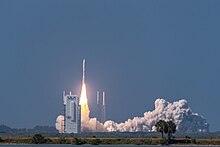
The service also chose the title "Guardian" to represent its personnel, becoming its counterpart to Soldier and Airman. The term "Guardian" has a long history within Air Force Space Command, originally serving as part of its motto: "Guardians of the High Frontier."[43] The Space Force also adopted Semper Supra as its official motto and unveiled its service song, sharing the same name.[44] The decision on if the Space Force's ranks would mirror the Army, like the Air Force and Marine Corps, or the Navy, generated significant controversy, with Congressman Dan Crenshaw introducing an amendment which would force the Space Force to pattern itself after the Navy's rank structure.[45] Ultimately, the amendment failed and the Space Force followed an Air Force/Army/Marine Corps-based rank scheme.[6]
The Space Force began to officially incorporate former Air Force Space Command units in 2020 and 2021, standing up field commands to serve as counterparts to the Air Force's major commands. It also consolidated Air Force wings and groups into mission deltas, a formation roughly equivalent to an Army Brigade Combat Team or Air Force expeditionary wing, and space base deltas (briefly known as garrisons), equivalent to an Army garrison or Air Force air base wing.[46][47] It also began to rename former Air Force bases and station to Space Force bases and station, starting with Patrick Space Force Base and Cape Canaveral Space Force Station.[48] It also established component field commands to serve as Space Force components at the unified combatant commands, assuming space component responsibility from the U.S. Air Force.[49]

One of the primary reasons the Space Force was created was to consolidate space forces from across the U.S. Air Force, U.S. Army, and U.S. Navy.[28] In 2020, the Space Training and Readiness Delta (Provisional) was established to form the foundation for Space Training and Readiness Command and incorporate Air Force space units spread across Air Combat Command and Air Education and Training Command, while Space Systems Command incorporated space acquisitions activities across Air Force Materiel Command, although, notably it did not incorporate space research and development conducted by the Air Force Research Laboratory.[50][51] The Space Force also began incorporating space personnel transfers from the U.S. Army, U.S. Navy, and U.S. Marine Corps.[52] In 2022, it the Naval Satellite Operations Center and Army's Satellite Operations Brigade transferred to the Space Force, putting satellite communications under a single service for the first time in history.[53][54] In 2023, it assumed responsibility for the Army's Joint Tactical Ground Station, putting all space-based missile warning under the Space Force.[55]
The Space Force's first significant combat action occurred less than a month after its establishment, providing missile warning when Iran launched missile strikes against U.S. troops at Al Asad Airbase on 7 January 2020.[56] In 2021, the Russian Federation conducted an anti-satellite weapons test, destroying the Kosmos 1408 and putting the International Space Station at risk.[57]
Organization

The Space Force is organized into a headquarters staff that provides leadership and guidance for the force; field commands that are responsible for organizing, training, and equipping Guardians; deltas that support field commands and are specialized by mission area; and squadrons which specialize in acquisitions, cyberspace operations, engineering, intelligence, and space operations.[6]
Headquarters Space Force
At the headquarters level, the Space Force is led by the Chief of Space Operations, a four-star general who reports to the Secretary of the Air Force and provides military advice to civilian leadership of the Department of Defense and the White House. Alongside the U.S. Air Force and U.S. Space Force combine to form the Department of the Air Force, like how the U.S. Navy and U.S. Marine Corps combine to form the Department of the Navy.[6]
Field commands, Space Force elements, and direct reporting units
The Space Force's three field commands (FLDCOM) are purpose-built for specific activities, aligning to the various institutional responsibilities to organize, train, and equip Guardians. Component field commands (C-FLDCOM) coordinate and integrate space forces into planning and current operations within unified combatant commands. Direct reporting units (DRU) are hubs of innovation and intelligence expertise within the Space Force, providing new ideas or deep knowledge about highly specialized issues.[6]
| Field command | Mission | Headquarters | |
|---|---|---|---|
| Space Operations Command (SpOC) | Generates, presents, and sustains space warfighting capability for combatant commanders | Peterson SFB, Colorado | |
| Space Systems Command (SSC) | Develops, acquires, equips, fields, and sustains lethal and resilient space capabilities | Los Angeles AFB, California | |
| Space Training and Readiness Command (STARCOM) | Increases Guardians' readiness to prevail in competition and conflict through education, training, doctrine, and test | Peterson SFB, Colorado | |
| Component field command | Mission | Headquarters | |
| U.S. Space Forces – Space (SPACEFOR–SPACE) | The U.S. Space Force component to U.S. Space Command which plans, executes, and integrates military spacepower into multi-domain global operations for all U.S. military operations beginning at the Kármán line, 62 miles/100 kilometers above mean sea level | Vandenberg SFB, California | |
| U.S. Space Forces – Central (SPACEFOR–CENT) | The U.S. Space Force component to U.S. Central Command which plans, executes, and integrates military power across an area of responsibility that spans Northeast Africa, the Middle East, and Central and South Asia | MacDill AFB, Florida | |
| U.S. Space Forces – Europe and Africa (SPACEFOR–EURAF) | The U.S. Space Force component to U.S. European Command and U.S. Africa Command which plans, executes, and integrates military spacepower across an area of responsibility that spans Europe, large portions of Asia, the Middle East, Artic Ocean, and Atlantic Ocean and Africa | Ramstein AB, Germany | |
| U.S. Space Forces – Indo-Pacific (SPAFOR-INDOPAC) | The U.S. Space Force component to U.S. Indo-Pacific Command which plans, executes, and integrates military spacepower across an area of responsibility that spans the Asia-Pacific region | JB Pearl Harbor-Hickam, Hawaii | |
| Space Force Element | Mission | Headquarters | |
| Space Force Element National Reconnaissance Office (SFELM NRO) | Supports the design, development, launch, and maintenance of America's intelligence satellites | Chantilly, Virginia | |
| Direct Reporting Unit | Mission | Headquarters | |
| Space Development Agency (SDA) | Develops, demonstrates, and transitions resilient military space-based sensing, tracking, and data transport capabilities into a proliferated multi-orbit architecture, encompassing government, commercial, and rapid acquisition architectures | The Pentagon, Arlington County, Virginia | |
| Space Rapid Capabilities Office (SpRCO) | Specializes in the expedited development and rapid production and deployment of space capabilities to fulfill short-term critical needs | Kirtland AFB, New Mexico | |
| Field Operating Agency | Mission | Headquarters | |
| National Space Intelligence Center (NSIC) | Delivers unparalleled technical expertise and game-changing intelligence – empowering national leaders, joint force warfighter and acquisition professionals to outwit, out-reach and win in the space domain[58] | Wright-Patterson AFB, Ohio | |
Bases
While the Space Force's headquarters is in Washington D.C., the rest of the service is spread across the United States and abroad, across 18 states and territories and 46 bases and installations as of 2024.[6]



